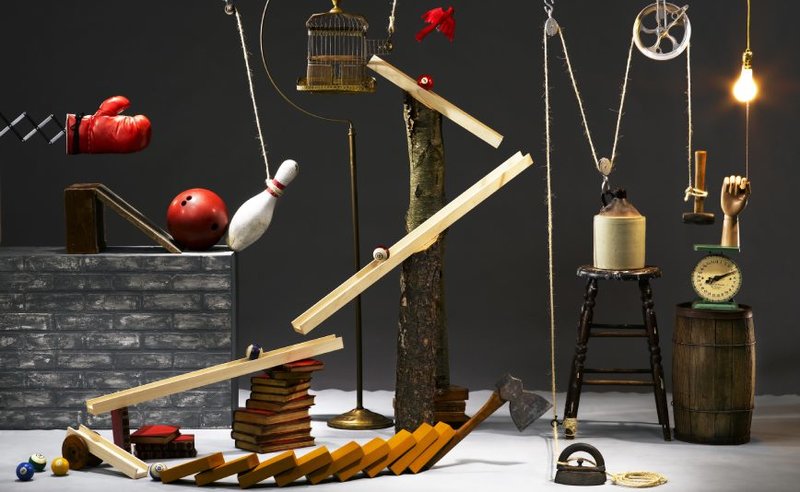Sagmeister: Man kann verschiedene Glücksarten nach Zeitdauer einteilen: Da gibts es das ganz Kurze, wie den sekundenlangen Glücksmoment oder auch den Orgasmus, eine mittellanges Glück wie die Zufriedenheit (kann stundenlang anhalten, auf dem Sofa mit der Zeitung und dem Hund am Sonntagnachmittag) und das ganze lange Glück: Das zu finden, was man mit seinem Leben machen will, den Lebenszweck, also etwas, was sehr eng mit Sinn verbunden ist.
Ich selber gehöre über die grösste Zeit meines Lebens zu den glücklicheren Menschen, ich würde sagen, so zwischen 7 und 8, auf einer Zehnerskala. Ich hatte ein kleines Rezept in Bali versucht: Man nehme einen Ipod, gefüllt mit einer Reihe von neuen, guten Liedern (die noch keine alten Erinnerungen hervorrufen), einen gelben Motorroller, eine unbefahrene schöne Strasse, keine Helmpflicht, so dass der Wind gespürt werden kann, mixe diese Zugaben und fahre ohne Ziel, nur um des Fahrens willen, durch Bali. Das hat bisher jedes Mal einen richtigen Glücksmoment hervorgerufen, inklusive Gänsehaut, wiederholbar, aber wahrscheinlich nicht endlos.
Und: Meine Erfahrung zeigt, dass mich im Allgemeinen viele und gute soziale Beziehungen glücklicher machen als das Alleinsein. Studien sagen dasselbe.
Der Verzicht als Glücksbringer kommt, glaube ich, aus dem Religiösen, die Fastenzeit als Mittel zur Selbstzucht und einer Art Erlösung. Ich kann das aus eigener Erfahrung nicht direkt nachvollziehen.
Wenn ich heute in einer Stadt wohne, dann ist all das, was mich umgibt, designed. Das Kleid, das ich anhabe, der Stuhl, auf dem ich sitze, die Wohnung, in der ich mich befinde, das Haus und die Strasse, der Park und der Stadtteil, alles wurde von Gestaltern gut – oder auch schlecht – designed. Das heisst, dass das Design auf einen zeitgenössischen Stadtbewohner den gleichen Einfluss hat wie die Natur auf einen Urwaldbewohner. Der Urwaldbewohner kann auf die Natur genauso wenig verzichten wie der Stadtbewohner auf das Design.
Schönheit ist die Kombination von Gestalt, Farbe, Materialität, Komposition und Form, die meine ästhetischen Sinne anspricht, speziell mein Sehen.
Ich weiss, dass ich mich in einer schönen Umgebung besser verhalte. Ich fühle mich auch besser. Ich selber gehe jeden morgen auf der High Line in New York laufen, und habe dort noch nie ein weggeworfenes Papierchen gesehen. Fünfzig Meter von der High Line im benachbarten Meatpacking District liegt viel Abfall in den Rinnsteinen. Die Sorgfalt, mit der die High Line gestaltet ist, verändert das Verhalten der Besucher.
Etwas Neues beinhaltet immer auch etwas Überraschendes, etwas Ungewöhnliches. Da wir uns alle an alles schnell gewöhnen, hat etwas Neues zumindest kurzzeitig die Chance, die Monotonie zu durchbrechen. Das Neue im Design ist häufig an neue Technologien gebunden, derzeit daher oft mit VR, AR oder AI verknüpft.
Das Traurige an der Innovation in der Grafik ist, dass viel Energie ins Schneller und Billiger, vergleichsweise, aber wenig ins Besser geht. Ich hab letztes Wochenende eine Fotobuch von Richard Avedon von 1962 gesehen. Die Druckqualität wäre heute nur schwer reproduzierbar. 50 Jahre unglaublichster Innovation in diesem Bereich haben da eigenartigerweise wenig vorwärts gebracht.

Twitter: #trendday2022